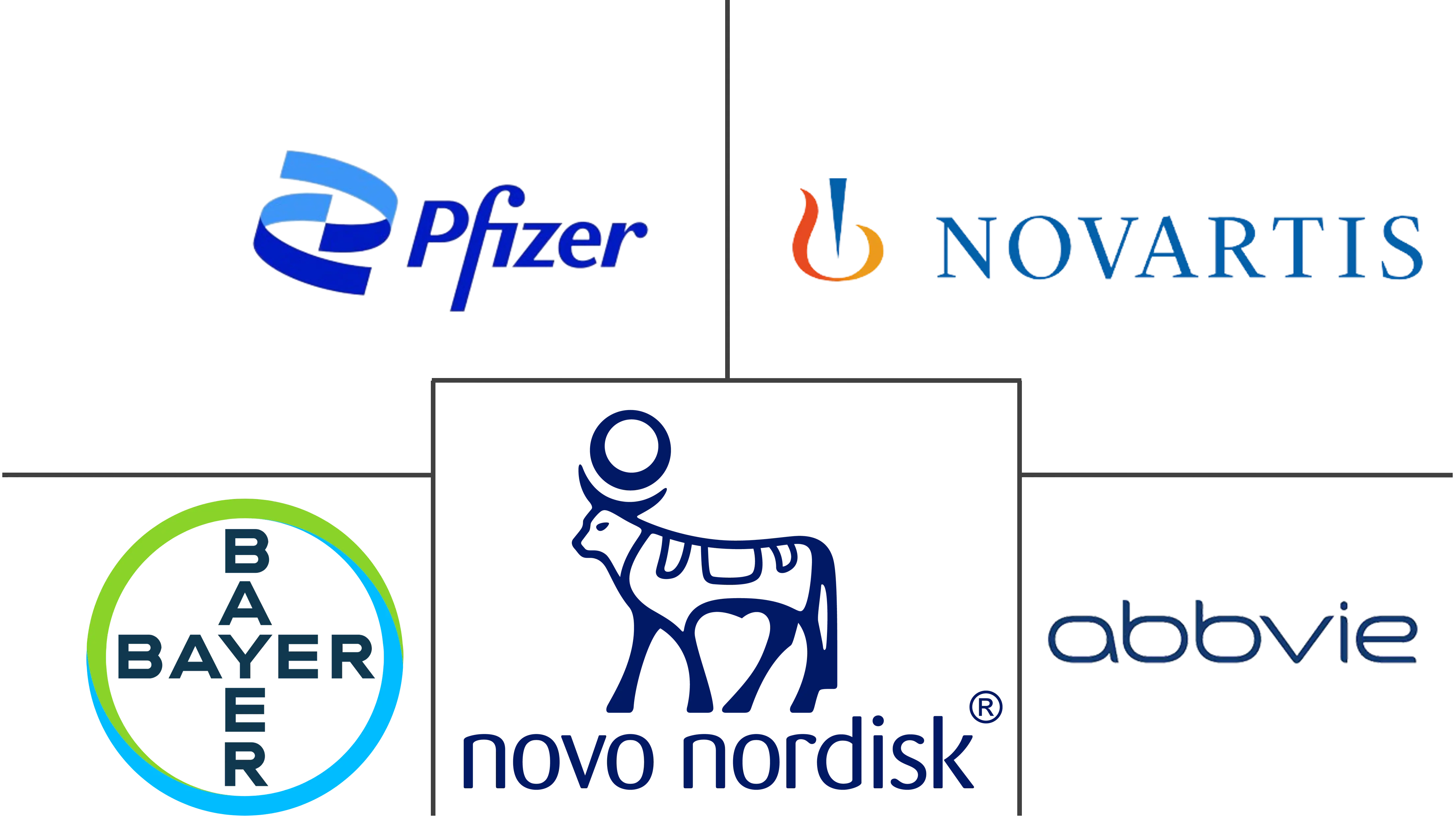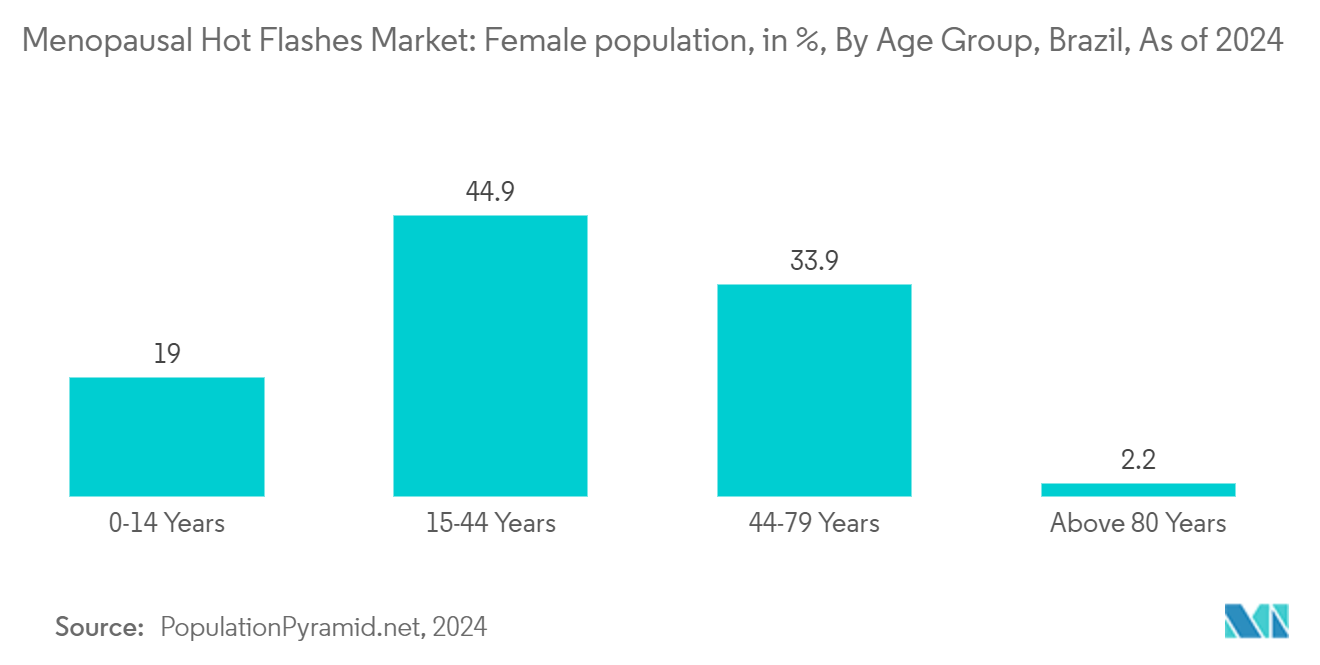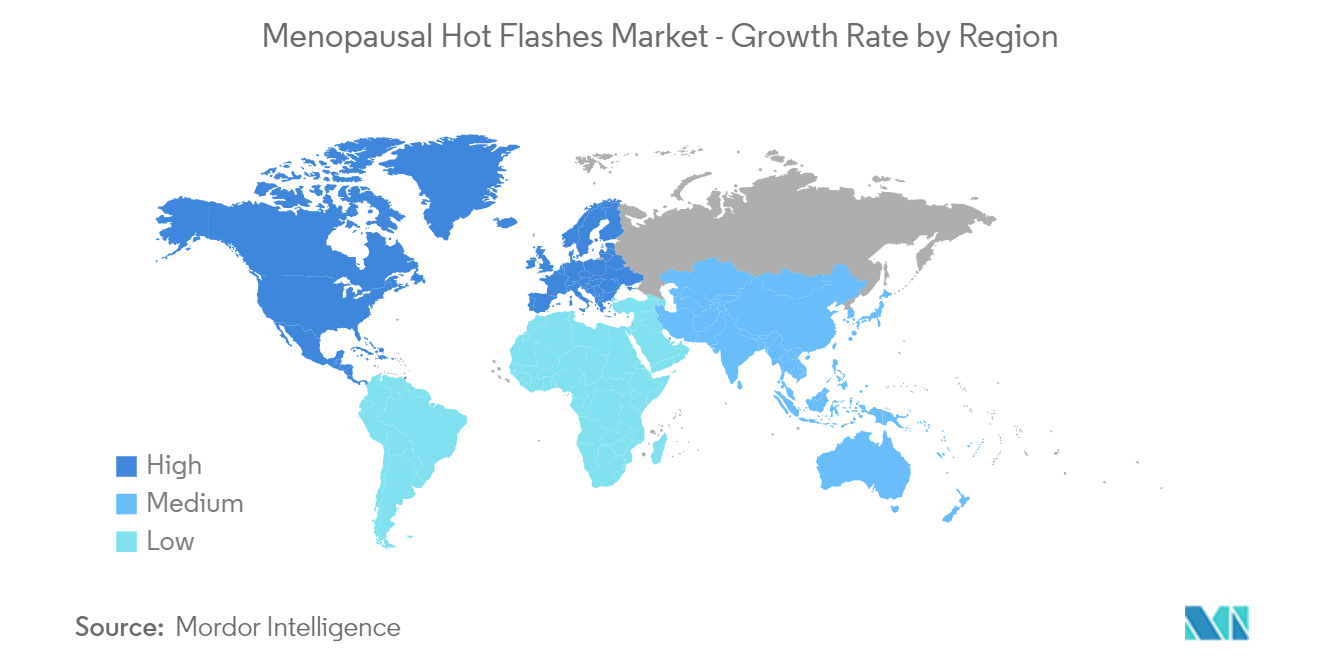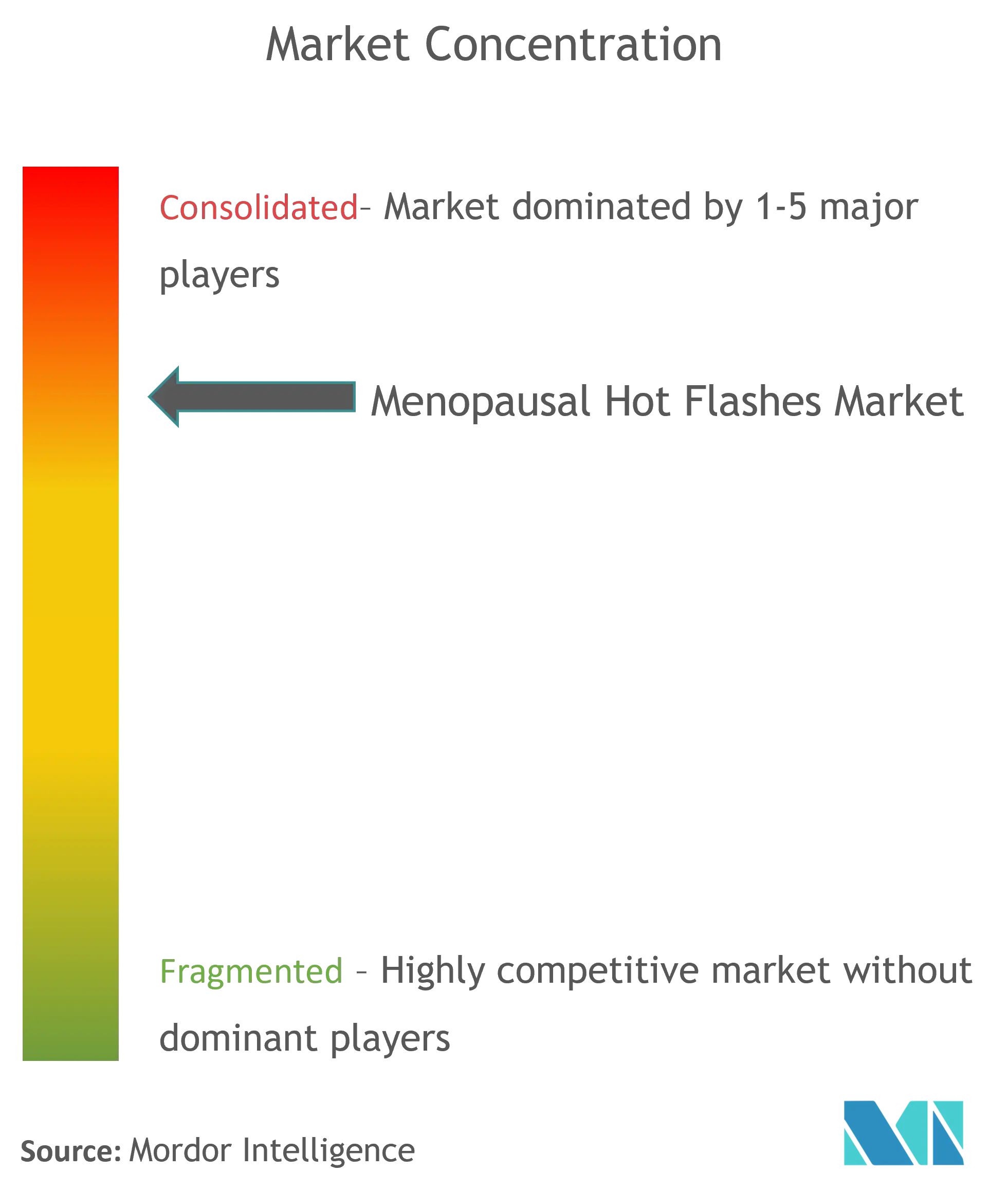Menopausal Hot Flashes Market Size

| Study Period | 2021 - 2029 |
| Market Size (2024) | USD 6.91 Billion |
| Market Size (2029) | USD 8.82 Billion |
| CAGR (2024 - 2029) | 5.02 % |
| Fastest Growing Market | Asia Pacific |
| Largest Market | North America |
Major Players
*Disclaimer: Major Players sorted in no particular order |
Menopausal Hot Flashes Market Analysis
The Menopausal Hot Flashes Market size is estimated at USD 6.91 billion in 2024, and is expected to reach USD 8.82 billion by 2029, growing at a CAGR of 5.02% during the forecast period (2024-2029).
Menopausal vasomotor symptoms (MVS), or hot flashes and night sweats, are often considered the cardinal symptoms of menopause. MVS are episodes of profuse heat accompanied by sweating and flushing, experienced predominantly around the head, neck, chest, and upper back.
The increasing incidence of vasomotor symptoms in menopausal women is expected to increase the utilization of drugs such as Climara, Delestrogen, and Elestrin, which is expected to drive market growth over the forecast period.
For instance, according to an article published in December 2023 in the Journal of the Menopause Society, an online study that contains 12,268 postmenopausal women from different countries, such as Brazil, Canada, Mexico, and four Nordic countries (Denmark, Finland, Norway, and Sweden), the prevalence of moderate to severe VMS was about 15.6%. Hence, the high prevalence of VMS across the globe is expected to drive the growth of the market over the forecast period.
According to the same article mentioned above, the highest prevalence of vasomotor symptoms was seen in Brazil, at 36%, and the lowest was in Nordic countries, at 11.6%. The severity of the symptoms in the participants affected their sleep negatively. Many women sought medical advice, but around 56.9% of the participants were not receiving treatment for their VMS. Hence, the high prevalence of menopausal vasomotor symptoms across the world is expected to increase the demand for hormonal therapy and non-hormonal therapies, which may ultimately drive the growth of the market over the forecast period.
The new researches are focused on the treatment of menopausal symptoms, targeting brain-based receptors to decrease side effects such as breast pain, acne, and hirsutism, which further increases patient compliance.
For instance, in May 2023, the US Food and Drug Administration approved Veozah (fezolinetant), an oral medication for the treatment of moderate to severe vasomotor symptoms, or hot flashes, caused by menopause. Hence, the launch of such novel products is expected to increase the accessibility for menopausal drugs, which may further drive the growth of the market over the forecast period.
Hence, the rising advancements in the development of novel drugs that target the receptors situated in the brain, such as neurokinin-1 and neurokinin-3, which reduce the body temperature and treat menopausal hot flashes in women who have contraindications to menopausal hormone therapy (MHT), is expected to accelerate the market growth over the forecast period.
Menopausal Hot Flashes Market Trends
The Estrogen Segment is Expected to Hold Significant Market Share
Estrogen is a primary female sex hormone produced mainly by the ovaries, the adrenal glands, and fat tissues. It plays a crucial role in regulating the menstrual cycle, promoting the development of secondary sexual characteristics (such as breast development and widening of the hips), and maintaining reproductive tissues. Estrogen levels fluctuate throughout a woman’s life, with significant decreases occurring during menopause.
The significance of estrogen in menopause hot flashes treatment is expected to increase its adoption and is likely to contribute to market growth over the forecast period. For instance, an article published in Frontier in October 2023 concluded that systemic estrogen therapy is the most effective treatment for relieving troublesome menopausal hot flashes and night sweats.
The article also noted that estrogen therapy can lessen menopausal vaginal symptoms like dryness, itching, burning, and discomfort during sex, as well as vulvovaginal atrophy, including vaginal dryness and painful intercourse. Thus, the efficacy of estrogen, as indicated by research studies, is anticipated to increase its demand, contributing to the segment growth over the forecast period.
Recent developments in estrogen hormone replacement therapy (HRT) have improved efficacy and safety profiles, making estrogen treatments more appealing. New combinations of estrogen with other hormones are being approved, further enhancing treatment options. For instance, in June 2023, Pfizer Inc. reintroduced DUAVEE (conjugated estrogens/bazedoxifene), an estrogen-based hormone therapy for menopause, to the US market. This comes after a voluntary recall, which was solely due to packaging concerns unrelated to the product's efficacy or safety. The reintroduced DUAVEE features enhanced packaging.
Thus, the high safety and efficacy profiles of estrogen therapy in menopausal hot flashes treatment with reduced risk of mortality in patients of breast cancer, growing supportive government initiatives, awareness of hormone replacement therapy with estrogen, and strategic activities by the industry players are expected to propel the segment growth over the forecast period.

North America is Expected to Hold Significant Market Share
North America is expected to witness significant growth in the menopausal hot flashes market due to the increased incidence of menopause, increased awareness of menopause, rising healthcare expenditure, and a large percentage of older women in the region.
Introducing new pharmacological options is expected to enhance patient satisfaction by providing alternatives to hormone replacement therapy (HRT) and influence market growth. For instance, in May 2023, the US Food and Drug Administration (FDA) approved Astellas Pharma US Inc.'s Veozah (fezolinetant), a novel oral medication for the treatment of moderate to severe vasomotor symptoms (VMS), commonly known as hot flashes, associated with menopause. Veozah represents a significant breakthrough as the first neurokinin 3 (NK3) receptor antagonist to receive FDA approval for this condition. The approval of Veozah marks a pivotal advancement in menopause management, offering a new treatment option for women who experience hot flashes. Consequently, product approvals in the country are likely to fuel market expansion.
The menopausal hot flashes market is witnessing significant advancements with clinical trials. For instance, in June 2023, VistaGen Therapeutics unveiled promising data on a neuroactive nasal spray, suggesting its potential to alleviate hot flashes during menopause. In a Phase 2A trial involving 36 patients, VistaGen's nasal spray successfully diminished the average daily count of menopausal hot flashes over a span of four weeks. These developments could significantly impact the menopause hot flashes market by providing a new, effective treatment option for managing symptoms.
Similarly, the treatment landscape for menopausal symptoms has expanded, with various options available to Canadian women. A study published in May 2023 by the Canadian Medical Association Journal confirmed that menopausal hormone therapy remains a first-line treatment for vasomotor symptoms, provided there are no contraindications. In Canada, systemic estrogens are available in several forms, including oral pills, transdermal patches, and gels, as well as vaginal formulations such as creams, tablets, and insertable rings.
The North American menopausal hot flashes market is undergoing a transformative phase characterized by innovative drug approvals and evolving research insights. The ongoing developments in this field promise to enhance treatment options and address the needs of millions of women experiencing the challenges of menopause.

Menopausal Hot Flashes Industry Overview
The menopausal hot flashes market is consolidated, with several key players. To maintain their market positions, companies are focusing on adopting various strategies, such as partnerships, collaborations, and product launches. Some of the companies currently dominating the market include AbbVie Inc. (Allergan PLC), Bayer AG, Novartis AG, Pfizer Inc., Novo Nordisk Corporation, Hisamitsu Pharmaceutical Co. Inc., and Theramex.
Menopausal Hot Flashes Market Leaders
-
Bayer AG
-
Novartis AG
-
Pfizer, Inc
-
Novo Nordisk Corporation
-
AbbVie Inc.(Allergan Plc)
*Disclaimer: Major Players sorted in no particular order

Menopausal Hot Flashes Market News
- August 2024: Bayer AG submitted a new drug application for elinzanetant to treat moderate to severe vasomotor symptoms associated with menopause to the US Food and Drug Administration.
- June 2023: Pfizer Inc. relaunched DUAVEE (conjugated estrogens/bazedoxifene), an estrogen-based menopause hormone therapy, in the United States after a voluntary recall. The recall was due to an issue with the packaging and not based on any efficacy or safety concerns with the product itself.
Menopausal Hot Flashes Market Report - Table of Contents
1. INTRODUCTION
- 1.1 Study Assumptions and Market Definition
- 1.2 Scope of the Study
2. RESEARCH METHODOLOGY
3. EXECUTIVE SUMMARY
4. MARKET DYNAMICS
- 4.1 Market Overview
-
4.2 Drivers
- 4.2.1 Rising Incidence of Menopausal Vasomotor Symptoms
- 4.2.2 Technological Advancements in the Development of New Drugs for Treatment
-
4.3 Restraints
- 4.3.1 Side Effects Associated with Hormonal Products
- 4.3.2 Availability Of Alternative Treatment Options Coupled With Low Treatment Adoption Rate
-
4.4 Porter's Five Forces Analysis
- 4.4.1 Bargaining Power of Suppliers
- 4.4.2 Bargaining Power of Consumers
- 4.4.3 Threat of New Entrants
- 4.4.4 Threat of Substitute Products and Services
- 4.4.5 Intensity of Competitive Rivalry
5. MARKET SEGMENTATION (Market Size by Value - USD)
-
5.1 By Treatment Type
- 5.1.1 Hormonal Treatment
- 5.1.1.1 Estrogen
- 5.1.1.2 Progesterone
- 5.1.1.3 Estrogen-progesterone Combination
- 5.1.2 Non-hormonal Treatment
- 5.1.2.1 Antidepressants
- 5.1.2.2 Other Non-hormonal Treatments
-
5.2 Geography
- 5.2.1 North America
- 5.2.1.1 United States
- 5.2.1.2 Canada
- 5.2.1.3 Mexico
- 5.2.2 Europe
- 5.2.2.1 Germany
- 5.2.2.2 United Kingdom
- 5.2.2.3 France
- 5.2.2.4 Italy
- 5.2.2.5 Spain
- 5.2.2.6 Rest of Europe
- 5.2.3 Asia-Pacific
- 5.2.3.1 China
- 5.2.3.2 Japan
- 5.2.3.3 India
- 5.2.3.4 Australia
- 5.2.3.5 South Korea
- 5.2.3.6 Rest of Asia-Pacific
- 5.2.4 Middle East and Africa
- 5.2.4.1 GCC
- 5.2.4.2 South Africa
- 5.2.4.3 Rest of Middle East and Africa
- 5.2.5 South America
- 5.2.5.1 Brazil
- 5.2.5.2 Argentina
- 5.2.5.3 Rest of South America
6. COMPETITIVE LANDSCAPE
-
6.1 COMPANY PROFILES
- 6.1.1 AbbVie Inc. (Allergan PLC)
- 6.1.2 Bayer AG
- 6.1.3 Novartis AG
- 6.1.4 Pfizer Inc
- 6.1.5 Novo Nordisk A/S
- 6.1.6 Hisamitsu Pharmaceutical Co. Inc. (Noven Pharmaceuticals Inc.)
- 6.1.7 Organon & Co.
- 6.1.8 Theramex
- 6.1.9 Besins Healthcare (ASCEND Therapeutics US LLC)
- 6.1.10 Astellas Pharma Inc.
- 6.1.11 Viatris Inc.
- 6.1.12 Mithra Pharmaceuticals
- 6.1.13 Knight Therapeutics Inc.
- *List Not Exhaustive
7. MARKET OPPORTUNITIES AND FUTURE TRENDS
** Subject To AvailablityMenopausal Hot Flashes Industry Segmentation
Menopausal hot flashes are the symptoms of menopause. They refer to uncomfortable feelings of warmth occurring during the menopause transition. Hot flashes are the most common symptom of perimenopause, a condition where ovaries gradually make less estrogen.
The menopausal hot flashes market is segmented by treatment type (hormonal treatment [estrogen, progesterone, and estrogen-progesterone combination] and non-hormonal treatment [antidepressant and other non-hormonal treatments]) and geography (North America, Europe, Asia-Pacific, Middle East and Africa, and South America). The report offers market sizes and forecasts in terms of value (USD) for all the above segments.
| By Treatment Type | Hormonal Treatment | Estrogen |
| Progesterone | ||
| Estrogen-progesterone Combination | ||
| By Treatment Type | Non-hormonal Treatment | Antidepressants |
| Other Non-hormonal Treatments | ||
| Geography | North America | United States |
| Canada | ||
| Mexico | ||
| Geography | Europe | Germany |
| United Kingdom | ||
| France | ||
| Italy | ||
| Spain | ||
| Rest of Europe | ||
| Geography | Asia-Pacific | China |
| Japan | ||
| India | ||
| Australia | ||
| South Korea | ||
| Rest of Asia-Pacific | ||
| Geography | Middle East and Africa | GCC |
| South Africa | ||
| Rest of Middle East and Africa | ||
| Geography | South America | Brazil |
| Argentina | ||
| Rest of South America |
Menopausal Hot Flashes Market Research FAQs
How big is the Menopausal Hot Flashes Market?
The Menopausal Hot Flashes Market size is expected to reach USD 6.91 billion in 2024 and grow at a CAGR of 5.02% to reach USD 8.82 billion by 2029.
What is the current Menopausal Hot Flashes Market size?
In 2024, the Menopausal Hot Flashes Market size is expected to reach USD 6.91 billion.
Who are the key players in Menopausal Hot Flashes Market?
Bayer AG, Novartis AG, Pfizer, Inc, Novo Nordisk Corporation and AbbVie Inc.(Allergan Plc) are the major companies operating in the Menopausal Hot Flashes Market.
Which is the fastest growing region in Menopausal Hot Flashes Market?
Asia Pacific is estimated to grow at the highest CAGR over the forecast period (2024-2029).
Which region has the biggest share in Menopausal Hot Flashes Market?
In 2024, the North America accounts for the largest market share in Menopausal Hot Flashes Market.
What years does this Menopausal Hot Flashes Market cover, and what was the market size in 2023?
In 2023, the Menopausal Hot Flashes Market size was estimated at USD 6.56 billion. The report covers the Menopausal Hot Flashes Market historical market size for years: 2021, 2022 and 2023. The report also forecasts the Menopausal Hot Flashes Market size for years: 2024, 2025, 2026, 2027, 2028 and 2029.
Vasomotor Symptoms Industry Report
Statistics for the 2024 Vasomotor Symptoms market share, size and revenue growth rate, created by Mordor Intelligence™ Industry Reports. Vasomotor Symptoms analysis includes a market forecast outlook 2029 and historical overview. Get a sample of this industry analysis as a free report PDF download.



